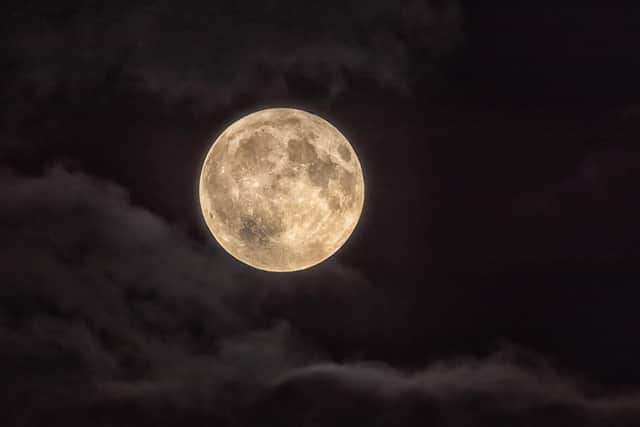When is the next full moon? Date of July 2021 full moon in UK, what is a Buck Moon - and how to see it
Some believe they’re lucky, others believe they can make you mad and some just simply enjoy the experience of watching a full moon.
To the delight of moongazers, another one is just around the corner, although it’s just a regular full moon and not a supermoon.
Advertisement
Hide AdAdvertisement
Hide AdEach full moon is known by a unique name, and July’s is sometimes referred to as the Buck Moon after male deer regrowing their antlers in summer.


So when is the July full moon, where does the name come from - and how can you see it from the UK?
Here’s what you need to know.
Why do full moons occur?
A full moon is when the moon appears as a complete circle in the sky, thanks to the sun’s rays lighting up the whole side of the moon that is facing the Earth.
This makes the full side of the moon visible to the naked eye, since it produces no light of its own.
The main source of light for the moon is the sun, although a small amount comes from distant stars and the reflection of light from the Earth.
The time it takes from a new moon - when the moon is between the Earth and the sun’s orbit and the side facing us is in darkness - to become a full moon is about 29.5 days.
When is the July full moon?
The next full moon is on Saturday 24 July 2021.
The one before that was the Strawberry Moon, which happened on 24 June.
What is a Buck Moon?
Advertisement
Hide AdAdvertisement
Hide AdEach full moon of the year has a name which comes from ancient origins.
Over time, different cultures have given names to full moons across the lunar calendar, with many coming from Native American tribes who used the cycles of the lunar phases as a method of timekeeping.
A lot of the names are associated with seasonal signs, like the blooming of flowers.
These names were then adopted by colonial Americans and subsequently entered popular culture.
In this case, the Buck Moon refers to male deer, which shed their antlers every year and begin to regrow them in July.
This moon is also sometimes called the Thunder Moon due to the storms that are common in July.
It can be called the Hay Moon, too, named after the July hay harvest.
Meanwhile, June’s Strawberry Moon was given its name due to the harvesting of strawberries that month, although Europeans know it as the Rose Moon.
How can I see the July full moon?
Advertisement
Hide AdAdvertisement
Hide AdOnly very keen moongazers might be able to stay up late enough to witness this month’s full moon in all its glory, as it will be visible from the UK at 3.36am on 24 July.
When is the next full moon?
There are 12 full moons in 2021, each with its own unique name.
After July’s Buck Moon, the next full moon to appear will be the Sturgeon Moon in August.
The full list of full moons is:
28 January – Wolf Moon
27 February – Snow Moon
28 March – Worm Moon
27 April – Pink Moon
26 May – Flower Moon
24 June – Strawberry Moon
24 July – Buck Moon
22 August – Sturgeon Moon
21 September – Corn Moon / Harvest Moon
20 October – Hunter's Moon
19 November – Beaver Moon
19 December – Cold Moon
Two of these are supermoons - the Pink Moon in April and the Flower Moon in May - when the full moon appears bigger and brighter than usual.
Comments
Want to join the conversation? Please or to comment on this article.
